ANN ARBOR, Mich. — While Kia may not have had the brand cachet of its competition in the past, the automaker has made big strides in the past decade through hard work, resulting in an improved overall image, especially to anyone who has driven its newer stock. Look at vehicles like the sporty Stinger and the formidable Telluride, for instance, both thoroughly enjoyable and more indicative of the brand’s ethos. For 2021, it’s the Sorento’s turn to get made over by a Kia Motors that now knows how to make excellent cars.
Our pair of 2021 Kia Sorentos arrived at the beginning of a December snow shower that would last, on and off, over the course of our brief loan. Both vehicles came equipped in SX-Prestige trim with the 2.5-liter turbo engine, one in front-wheel drive, the other an all-wheel-drive example with the X-Line package, which adds an inch of ground clearance and some rugged styling touches. After a night of snow and ice, the sun (presumably) rose over a cloud-covered sky. We scraped the Sorentos off and got to know all three rows of them.
Seeing the Sorentos in the flesh in our driveway, it was a promising start. Not because they look like a slightly smaller version of the Telluride, but because they don’t. It would have been easy for Kia to lean on the success of the Telluride and essentially copy it. Instead, Kia gave this car its own distinct personality, one that is considerably less frumpy than Sorentos past. Instead of the Telluride’s rugged handsomeness, the Sorento looks sharp and sporty. It’s a look that’s not only much fresher than the previous generation, but it also ought to help keep this three-row crossover from stepping on Kia’s other three-row crossover’s toes.
While the last generation improved things inside the Sorento, the fit and finish in the top trim of this new vehicle take it further, doing a fair impression of luxury. Materials come in soft and glossy plastics and leather, with never too much of any one surface left unbroken by a tactful stitch or texture or accent. The center stack replaces an old-looking infotainment unit with something entirely fresh. The doors all bow outward to maximize elbow room and help provide a sense of spaciousness in the cabin. The one thing that looks a little odd are the vents up front, particularly the tiny, almost vestigial-looking vents below the larger ones on the dash.
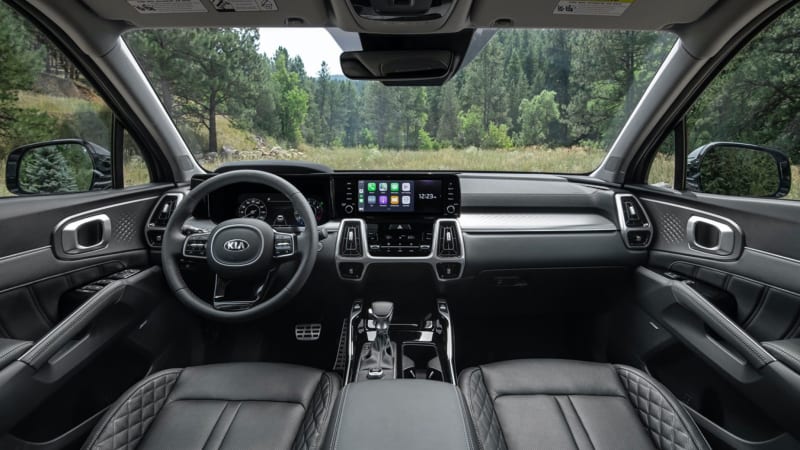
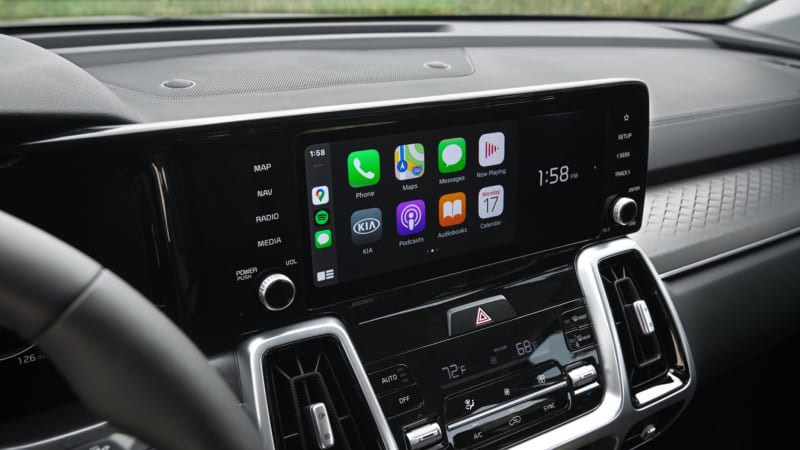
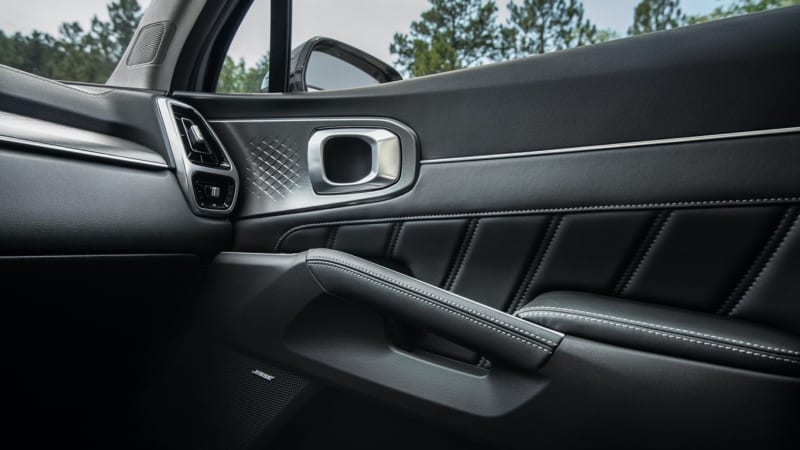
The digital instrument and touchscreen look and feel high-end. A lively and funky design scheme animates the interface – its use of pink and blue hues are reminiscent of a karaoke bar’s neon lights. And it feels like Kia put some effort into the design rather than plastering menus with clip-art icons. The infotainment screen is short in stature but wide, which allows for the display of a lot of useful information, but puts some of the controls at a long stretch of the right arm. We’d have liked some sort of controller on the center console, but the steering wheel controls were sufficient for quick track or volume changes.
Bluetooth-enabled Apple CarPlay and Android Auto are standard, but we liked the look and feel of Kia’s own user interface. It’s effectively a re-skinned version of the one that so impresses in the Genesis G80 and GV80. And as in those models, as well as newer Hyundais, a variety of pre-loaded soothing tracks is included to let you listen to the soft, clattery din of an open-air café or warm up to the sound of a warm fireplace crackling. Good choices for this year of quarantining and this day of snowy weather.
The Sorento starts at $30,560 including destination for the base LX FWD (AWD adds $1,800), and comes standard with a 191-horsepower naturally aspirated base four-cylinder, with hybrid and plug-in hybrid powertrains coming soon. Both of our testers, however, come with the 2.5-liter turbocharged inline-four, which is available in the EX trim ($36,160) on up through the SX-Prestige ($41,760). Its 281 hp and 311 pound-feet of torque compare favorably to the outgoing V6 engine’s 290 hp and 252 lb-ft — though a bit down on power, the turbo mill not only has greater torque, but it arrives at 1,700 rpm and stays there until the tach sweeps past 4,000.
Routed through a new eight-speed dual-clutch transmission, that power is put to the front wheels with alacrity. The overeager motivation results in some torque steer with the accelerator to the floor and, on snow-slick roads, this results in a good long wait while the stability control fights wheelspin for grip before it can get going. On merely damp roads, it’ll go immediately, but you’ll hear and feel those front wheels slip against the cold pavement for a long moment. This family hauler has no trouble hitting whatever far-ahead merge point on a freeway on-ramp to blend with traffic at the speed limit. Kia lists a modest 7.4-second 0-60 time in the Sorento FWD, but it feels quicker, especially around town.
With all-wheel drive, the turbo Sorento felt less spastic off the line, and significantly more confident as the snowfall began to accelerate. In addition to the Comfort, Eco, Sport and Smart drive modes of our FWD tester, AWD adds a Snow mode, prefect for the day’s worsening conditions. We spent many miles on iced-over dirty roads and never felt out of sorts, and the X-Line’s extra bit of clearance made things easier when we encountered ever more potholes. While we’d normally suggest winter tires, those who go without will notice a big difference between FWD and AWD models when driving in snow.
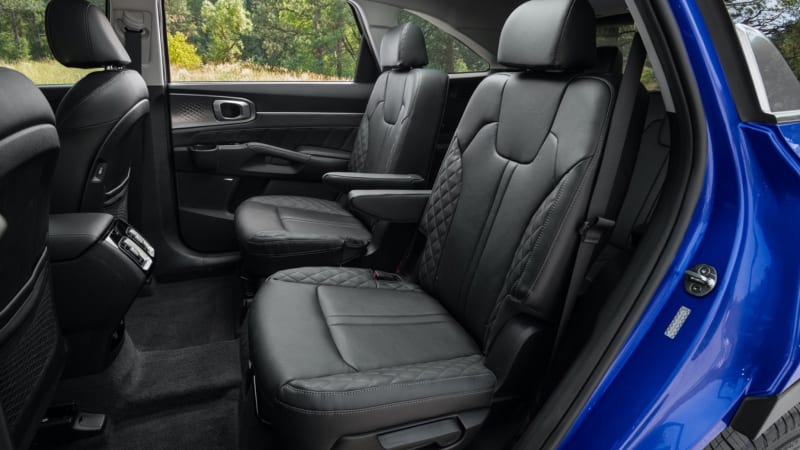
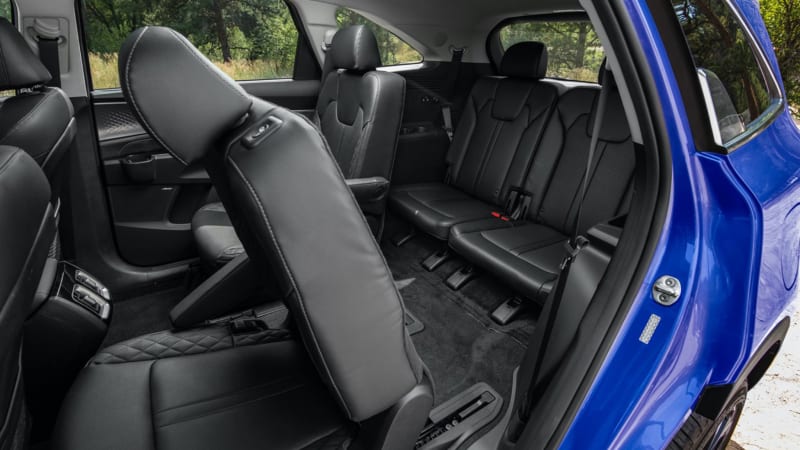
This new Sorento improves upon the previous version with better handling. It feels more connected, with less squishy ride (even a bit on the stiff side with these testers’ 20-inch wheels) that improves cornering and body roll without letting every road imperfection jar the occupants. The steering has a decent heft to it, again feeling more connected, weighting up with steering angle and reacting to the road beneath it. For a three-row crossover, the new Sorento can actually hold up to those more spirited errand runs without punishing the driver with either sloppy response or a crashy experience.
The new Sorento benefits from the multi-layered blind-spot warning system increasingly applied throughout the Hyundai empire, and that took home the 2020 Autoblog Technology of the Year award for its use in the Kia Telluride. The centerpiece of this system is a pair of blind spot cameras that activate when you use the Sorento’s turn signal. Signal left, and the feed of your driver-side blind spot appears in place of the speedometer in the digital dash. Signal right, and the passenger-side blind spot is viewable on the right side of the cluster, replacing the tachometer.
Bolstering the safety and convenience of the Sorento’s drive experience is a smart cruise control system that works well. The adaptive cruise keeps you comfortably out of the leading car’s tailgate, with the ability to adjust the following distance via a single button on the steering wheel. The steering assist also performs beautifully, keeping the vehicle centered in its lane through curves in the road, and without the resultant nagging from lane minders that often underperform in other vehicles. The result is a comfortable, stress-free commute even as highway traffic speeds change regularly due to things like congestion, or slow-moving salt trucks on the road.
Though a second-row bench is an option, both our testers had captain’s chairs, for a total of six seats. Above the first two rows, a huge panoramic sunroof provided views of the cloudy sky once the icy crust had evaporated. The second-row seats each get their own USB port in the seatback of the row ahead, plus a shared USB port and 12-volt supply in the back of the center console.
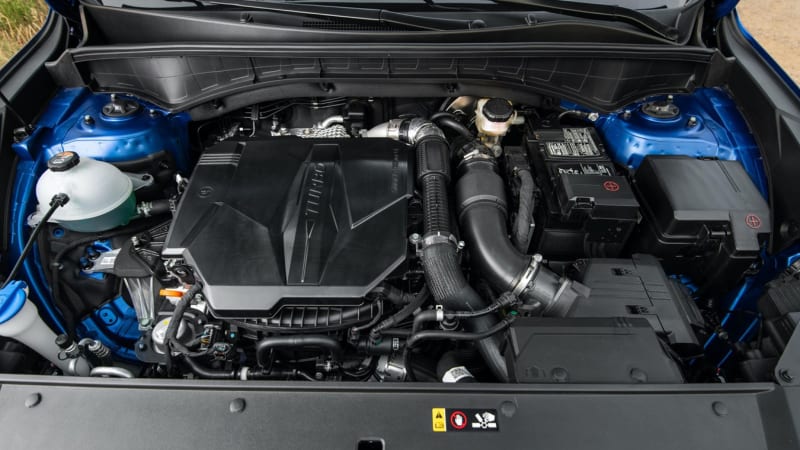
The third row’s pair of seats aren’t huge, and the high floor elevates your knees chin-ward. It’s livable for a full-grown adult, though, especially if the passenger in front of you sacrifices some of their legroom to provide you with some of your own. It’s surprisingly far more usable than the third row in the Toyota Highlander, which has considerably more rear cargo space behind it, but basically requires adults to remove their feet to sit back there. Along with a cupholder and storage cutout for a phone or the like, each side gets another USB port of its own. The passenger-side occupant can also make use of the cargo area’s 12-volt outlet, which resides in front of the third-row seatback when up. We’d want something bigger if we were to put people in the way back on a daily basis, but it’s well suited to occasional or even weekly use.
The evolved Kia Sorento is a well-executed three-row midsize SUV. It’s on the small side of the segment, but that offers its own advantages for customers who dwell in cities or have a small garage. It offers a winning combination of technology, styling, practicality and value. We look forward to seeing if the naturally aspirated version’s sacrificed power is worth the lower cost (as it doesn’t fare much better in fuel economy), or how the hybrid shakes out against its only competitor, the Highlander Hybrid. We’re especially eager to test the coming plug-in hybrid version. Equipped with the 2.5T and all-wheel drive, the 2021 Sorento is a capable CUV with personality and useful features. If you need three rows, quality safety tech and a dash of style in a slightly smaller format, Kia’s got you covered. More to come.
Related Video:

